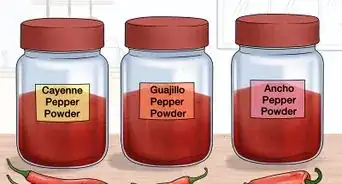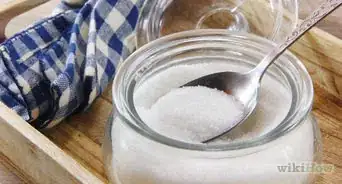This article was co-authored by wikiHow Staff. Our trained team of editors and researchers validate articles for accuracy and comprehensiveness. wikiHow's Content Management Team carefully monitors the work from our editorial staff to ensure that each article is backed by trusted research and meets our high quality standards.
This article has been viewed 21,506 times.
Learn more...
Not only does turmeric taste delicious in everything from tofu to a cup of tea, turmeric is also known for its health benefits. When you learn to dry turmeric at home you will have easy access to a seasoning that fills your dishes with flavor and enhances the health of your heart. For all of the following methods it’s necessary to boil the turmeric for around 45 minutes before beginning the drying process.
Steps
Drying Turmeric with Natural Sunlight
-
1Slice the rhizomes into thin pieces. Aim for thin slices so that you can create the greatest amount of surface area. The more surface area, the faster your turmeric will be ready to star in its first recipe.[1] .
-
2Place a thin layer of rhizomes in non-direct sunlight. Once you have sliced the rhizomes, it’s time for them to sunbathe. Spread the rhizomes in a 5–7 centimetres (2.0–2.8 in) layer on either a bamboo mat or a drying floor.[2] Be sure to avoid direct sunlight since it will drain your turmeric of its prized yellow color.Advertisement
-
3Cover the rhizomes at night. Cover your turmeric in cloth or heap it together. This will help control air flow and help enhance the quality of your turmeric.
-
4Repeat drying process for 10-15 days. The dry time of your turmeric will vary based on climate. You will know your turmeric is ready when it seems like there is 5-10% of the original moisture remaining.[3]
Drying Turmeric with a Dehydrator
-
1Skin and chop the turmeric. Begin by peeling the skin from your turmeric. Once you have removed the skin, slice the turmeric into thin, equal portioned pieces.[4]
-
2Set the dehydrator’s temperature to 105 °F (41 °C) and prepare the dehydrator tray. Spread your freshly chopped turmeric on a dehydrator tray and cover it in parchment paper. Place the tray in the oven and get ready to bake!
-
3Cook for four hours. At the end of four hours, remove the tray from the dehydrator. Your turmeric is now ready for grinding, storing, and cooking.
Drying Turmeric with an Oven
-
1Slice the turmeric into .15 centimetres (0.059 in) pieces. Aim to get as close to .15 centimetres (0.059 in) as possible when slicing your turmeric. These thin slices will help reduce dry time and speed up dinnertime![5]
-
2Set oven temperature to 115 °C (239 °F). While every oven is different, setting the temperature at around 115 °C (239 °F) will guarantee a steady drying process.[6] Be sure to spread your turmeric as thinly as possible on an oven-safe surface for the best results.
-
3Cook for 1 ½ to 2 hours. Dry time will depend on the thickness and initial water content of your turmeric. Start checking for results at around 90 minutes. It's almost time for your first tasty turmeric-based meal.[7]
Drying Turmeric with a Microwave
-
1Cut thin vertical slices. Begin the drying process by slicing your turmeric into thin vertical slices. This will increase the surface area of your turmeric and help speed up dry time.[8]
-
2Set the microwave temperature to around 445 watts. Spread your turmeric slices in a thin layer on a microwave-safe surface. Set the temperature to 445 watts and pop the turmeric in.
-
3Cook for 55 seconds. If you cook the turmeric for too long, then it’s color will be depleted. Get the richest turmeric possible when you cook it for about 55 seconds.[9]
Warnings
- Avoid sunlight if possible. Drying in the sun will cause more bleaching of color than the other methods listed.⧼thumbs_response⧽
- Avoid personal microwaves if possible. While microwaves are helpful in locations lacking in sunlight, they should be used only as a last resort.⧼thumbs_response⧽
References
- ↑ https://www.turmericforhealth.com/general-info/how-to-make-turmeric-powder-at-home-from-raw-turmeric
- ↑ https://www.celkau.in/Crops/Spices/Turmeric/processing.aspx
- ↑ https://www.turmericforhealth.com/general-info/how-to-make-turmeric-powder-at-home-from-raw-turmeric
- ↑ https://rockinwhomestead.com/ground-turmeric-from-fresh-roots/
- ↑ https://www.atlantis-press.com/proceedings/icst-18/55910795
- ↑ https://www.atlantis-press.com/proceedings/icst-18/55910795
- ↑ https://www.turmericforhealth.com/general-info/how-to-make-turmeric-powder-at-home-from-raw-turmeric
- ↑ https://www.turmericforhealth.com/general-info/how-to-make-turmeric-powder-at-home-from-raw-turmeric
- ↑ https://www.actahort.org/members/showpdf?booknrarnr=1088_111

































































